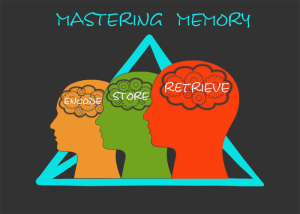20 Master Your Memory
What is memory?[1]

Memory is the ability to remember past experiences and is a record of the learning process.
The human brain has the ability, known as neuroplasticity, to form new neural pathways, alter existing connections, and adapt and react in ever-changing ways as we learn. We must have ways to retrieve information learned that’s stored in our long-term memory.
Long-term memory stores significant events that mark our lives. It lets us retain the meanings of words and the physical skills that we’ve learned.
There are 3 steps involved in establishing a long-term memory: encoding, storage, and retrieval.
- To encode, you assign meaning to the information.
- To store information, you review it and its meanings (study). Repetition is essential to remembering.
- To retrieve it, you follow the path you created through encoding. This might include memory triggers that you used when you were encoding.
What strategies help store information in long-term memory?[2]
Mnemonics (the initial “m” is silent) are strategies to associate the information we want to remember with a physical sense to turn it into something that’s more likely to stick in your mind and be able to bring it back when you want it.
The key idea is that by coding information using vivid mental images, you can reliably code both information and the structure of information. And because the images are vivid, they’re easy to recall when you need them. Here are some tips and examples:
- Use positive, pleasant images. Your brain often blocks out unpleasant ones.
- Use vivid, colourful, sense-laden images. These are easier to remember than drab ones.
- Use all your senses to code information or dress up an image by using sound, smell, taste, touch, movements, and feelings as well as pictures.
- Give your image three dimensions, movement, and space to make it more vivid.
- Exaggerate the size of important parts of the image.
- Use rhymes or humour! Funny things are easier to remember.
- Symbols (red traffic lights, pointing fingers, signs, etc.) can code quite complex messages.
| Type | Sample Method |
| Acronyms | Every discipline has its own language and acronyms are the abbreviations, Acronyms can be used to remember words in sequence or a group of words representing things or concepts. CAD can mean: Control Alt Delete, Canadian Dollar, Computer Aided Design, Coronary Artery Disease, , Crank Angle Degree, etc. |
| Acrostics | Acrostics are phrases where the first letter of each word represents another word. They are relatively easy to make and can be very useful for remembering groups of words. For example: King Philip Can Only Find His Green Slippers. This is the classification system of: Kingdom, Phylum, Class, Order, Family, Genus, Species. |
| Chunking | You can capitalize on your short-term memory by “chunking” information. If you need to remember this number: 178206781, the task would exhaust your seven units of storage space unless you “chunk” the digits in to groups. In this case, you could divide it into three chunks, like a social insurance number: 178 206 781. By chunking the information and repeating it you can stretch the capacity of your short term memory. |
| Images | This helps you remember by linking words to meanings through associations based on how a word sounds and creating imagery for specific words. This sort of visualization is found to be more effective when one listened to someone reading a text than when they read the text themselves. |
| Locations and Journeys | Traditionally known as the Method of Loci, we associate each word from a list or grouping, with a location. Imagine a place you’re familiar with, such as the rooms in your house. These become the objects of information you need to memorize. Another example is to use the route to your work or school, with landmarks along the way becoming the information you need to memorize. When you do this in order of your journey through the imagined space, it makes it easier to retrieve the information in the future. |
| Maps & Diagrams | Graphic organizers help you remember by connecting new information to your existing knowledge and to let us see how concepts relate to each other and fit in to a context. Mind and concept maps, Cause and Effect, Fishbone, Cycle, Flow Chart, Ladders, Story Board, Compare and Contrast, Venn Diagrams, and more. |
| Reciting | Saying something out loud activates more areas of our brain and helps to connect information to other activities. |
| Rhymes | Rhyme, rhythm, repetition, and melody make use of your brain’s ability to encode audio information and use patterns to aid memory. They help recall by limiting the possible options to those items that fit the pattern you have created. |
| Summarizing | This traditional element of note taking is a way to physically encode materials which make it easier for your brain to store and retrieve. It can be said that if we cannot summarize, then we have not learned…yet. |
Try it!
Select one course where memorizing key concepts is part of your exam preparation.
- Choose at least one new strategy from the chart above this week.
- Monitor – is this strategy effective for what you’re trying to learn?
- A good way to monitor is to see if you can recall the information accurately without looking at a text or notes.
Extend Your Learning
Check out this resource on studying and memory:
- Essential Study Skills by Algonquin College
- Dubuc, B. (2002). Memory and learning. The Brain from top to bottom. http://thebrain.mcgill.ca/flash/a/a_07/a_07_p/a_07_p_tra/a_07_p_tra.html ↵
- MindTools Content Team. (n.d.). Introduction to memory techniques. https://www.mindtools.com/memory.html ↵
- Dubuc, B. (2002). Memory and learning. The Brain from top to bottom. http://thebrain.mcgill.ca/flash/a/a_07/a_07_p/a_07_p_tra/a_07_p_tra.html ↵
- Whitehead, J., Fraenkel, C., Yu, E., & Van Der Mark, A. (2017, February 1). Memory. http://etec.ctlt.ubc.ca/510wiki/index.php?title=Memory&oldid=63689 ↵

